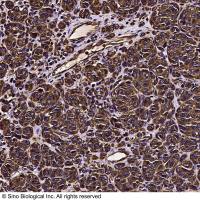Detecting Low‐Affinity Extracellular Protein Interactions Using Protein Microarrays
互联网
- Abstract
- Table of Contents
- Materials
- Figures
- Literature Cited
Abstract
Low?affinity extracellular protein interactions are critical for cellular recognition processes, but are not generally detected by methods that can be applied in a high?throughput manner. This unit describes a protein microarray platform that significantly improves the throughput of assays capable of detecting transient extracellular protein interactions. These methodological improvements now permit screening for novel extracellular receptor?ligand interactions on a genome?wide scale. Curr. Protoc. Protein Sci. 72:27.5.1?27.5.15. © 2013 by John Wiley & Sons, Inc.
Keywords: receptor?ligand pairs; extracellular protein interactions; AVEXIS; adhesion receptors; transient/weak interactions; high?throughput screening; microarray
Table of Contents
- Introduction
- Basic Protocol 1: Preparation of Microarray AVEXIS Assay
- Support Protocol 1: High‐Throughput Purification of 6His‐Tagged Proteins
- Reagents and Solutions
- Commentary
- Literature Cited
- Figures
Materials
Basic Protocol 1: Preparation of Microarray AVEXIS Assay
Materials
Support Protocol 1: High‐Throughput Purification of 6His‐Tagged Proteins
|
Figures
-
Figure 27.5.1 Workflows involved in low‐affinity interaction detection by AVEXIS. Bait and prey proteins are produced as soluble recombinant proteins by transiently transfecting a mammalian cell line. The proteins are purified using an oligo‐His tag using a bespoke purification apparatus (the “Protein Press”) and subsequently printed onto glass slides before screening for interactions. View Image -
Figure 27.5.2 Flowchart showing the salient features of the bait and prey proteins, microarray printing and AVEXIS interaction screening. (A ) Design of the monomeric enzymatically monobiotinylated bait and pentamerized, enzyme‐tagged prey proteins. (B ) Construction of the protein microarrays by printing the monomeric biotinylated bait proteins on streptavidin‐coated slides. (C ) Procedure for screening of the protein microarrays with the prey proteins to detect interactions. View Image -
Figure 27.5.3 An image of a processed microarray slide illustrating typical results. Bait proteins were serially diluted and printed onto a microarray (with the most concentrated solutions at the top) before being probed with an appropriate prey. Positive interactions are detected in a concentration‐dependent manner. The slides also contain prey‐positive controls, landing marks (biotinylated HRP), and negative controls. View Image
Videos
Literature Cited
| Literature Cited | |
| Bushell, K.M., Sollner, C., Schuster‐Boeckler, B., Bateman, A., and Wright, G.J. 2008. Large‐scale screening for novel low‐affinity extracellular protein interactions. Genome Res. 18:622‐630. | |
| Crosnier, C., Bustamante, L.Y., Bartholdson, S.J., Bei, A.K., Theron, M., Uchikawa, M., Mboup, S., Ndir, O., Kwiatkowski, D.P., Duraisingh, M.T., Rayner, J.C., and Wright, G.J. 2011. Basigin is a receptor essential for erythrocyte invasion by Plasmodium falciparum. Nature 480:534‐537. | |
| Dustin, M.L., Golan, D.E., Zhu, D.M., Miller, J.M., Meier, W., Davies, E.A., and van der Merwe, P.A. 1997. Low affinity interaction of human or rat T cell adhesion molecule CD2 with its ligand aligns adhering membranes to achieve high physiological affinity. J. Biol. Chem. 272:30889‐30898. | |
| Kerr, J.S. and Wright, G.J. 2012. Avidity‐based extracellular interaction screening (AVEXIS) for the scalable detection of low‐affinity extracellular receptor‐ligand interactions. J. Vis. Exp. e3881. | |
| Letarte, M., Voulgaraki, D., Hatherley, D., Foster‐Cuevas, M., Saunders, N.J., and Barclay, A.N. 2005. Analysis of leukocyte membrane protein interactions using protein microarrays. BMC Biochem. 6:2. | |
| Martin, S., Sollner, C., Charoensawan, V., Adryan, B., Thisse, B., Thisse, C., Teichmann, S., and Wright, G.J. 2010. Construction of a large extracellular protein interaction network and its resolution by spatiotemporal expression profiling. Mol. Cell Proteomics 9:2654‐2665. | |
| Powell, G.T. and Wright, G.J. 2011. Jamb and Jamc are essential for vertebrate myocyte fusion. PLoS Biol. 9:e1001216. | |
| Ramani, S.R., Tom, I., Lewin‐Koh, N., Wranik, B., Depalatis, L., Zhang, J., Eaton, D., and Gonzalez, L.C. 2012. A secreted protein microarray platform for extracellular protein interaction discovery. Anal. Biochem. 420:127‐138. | |
| Sollner, C. and Wright, G.J. 2009. A cell surface interaction network of neural leucine‐rich repeat receptors. Genome Biol. 10:R99. | |
| Sun, Y., Gallagher‐Jones, M., Barker, C., and Wright, G.J. 2012. A benchmarked protein microarray‐based platform for the identification of novel low‐affinity extracellular protein interactions. Anal. Biochem. 424:45‐53. | |
| van der Merwe, P.A. and Barclay, A.N. 1994. Transient intercellular adhesion: the importance of weak protein‐protein interactions. Trends Biochem. Sci. 19:354‐358. | |
| Wojtowicz, W.M., Wu, W., Andre, I., Qian, B., Baker, D., and Zipursky, S.L. 2007. A vast repertoire of Dscam binding specificities arises from modular interactions of variable Ig domains. Cell 130:1134‐1145. | |
| Wright, G.J. 2009. Signal initiation in biological systems: The properties and detection of transient extracellular protein interactions. Mol. BioSystems 5:1405‐1412. |








